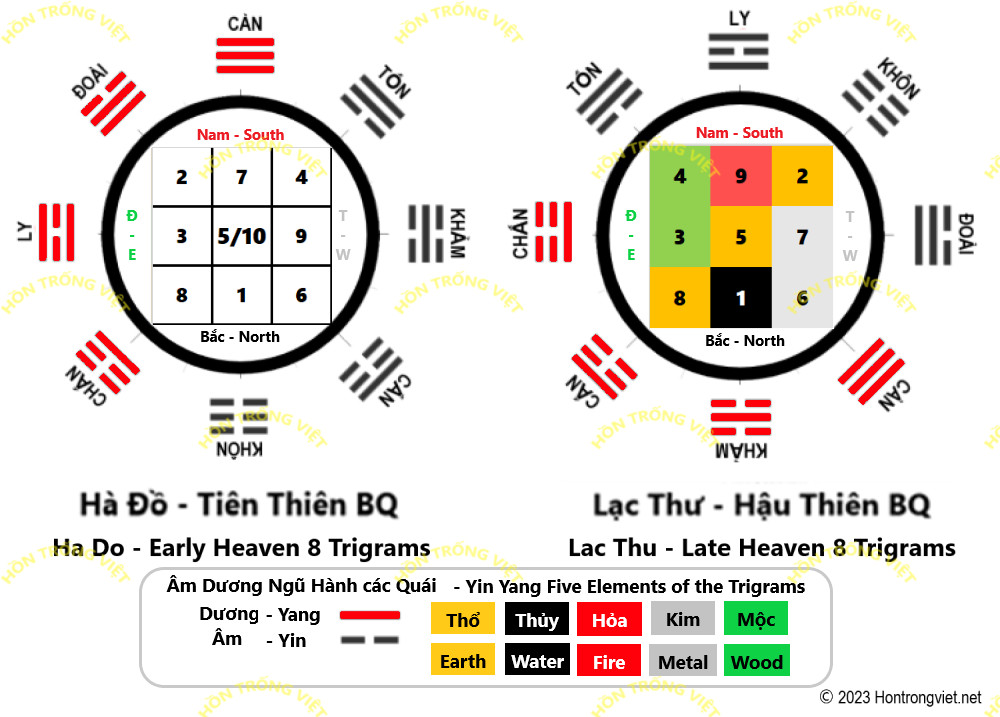
I Ching (Chinese: 易經) or Book of Changes, with its symbol Tai Chi, is considered one of the Five Classics, expressing the philosophy of the ancient China with profound influence in the Far East & Vietnam for thousands of years.
“The most peculiar thing is that the Book of changes is only built on the theory of yin yang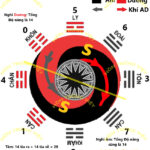 DTV coi quái Càn, Tinh thần, vô hình, vô hạn, vạch liền, số lượng lẻ, vòng tròn & màu đen là âm, còn quái Khôn,... More, on a solid line – represents yang, a dashed line – – represents yin, those two lines overlap, interchange each other several times into eight trigrams, and then these eight trigrams overlap into sixty-four hexagrams. Using these sixty-four figures, the Chinese can express all concepts of the universe, of human life, from heaven and earth phenomena, natural laws to utensils, daily tasks such as water treatment, military campaign, housekeeping, marriage, eating, behavior …”1Nguyễn Hiến Lê: Kinh Dịch Đạo Của Người Quân Tử, NXB Hồng Đức
DTV coi quái Càn, Tinh thần, vô hình, vô hạn, vạch liền, số lượng lẻ, vòng tròn & màu đen là âm, còn quái Khôn,... More, on a solid line – represents yang, a dashed line – – represents yin, those two lines overlap, interchange each other several times into eight trigrams, and then these eight trigrams overlap into sixty-four hexagrams. Using these sixty-four figures, the Chinese can express all concepts of the universe, of human life, from heaven and earth phenomena, natural laws to utensils, daily tasks such as water treatment, military campaign, housekeeping, marriage, eating, behavior …”1Nguyễn Hiến Lê: Kinh Dịch Đạo Của Người Quân Tử, NXB Hồng Đức
Since 18th century, once studied & applied by the Europeans, I Ching has become well known worldwide.
Brief History of the I Ching
The history of I Ching is not so simple & the followings are the key milestones & opinions that have been accepted by the majority of people.
Ha Do & Early Heaven Eight Trigrams
3500 BC: Legendary emperor Phuc Hy, by seeing Ha Do Hồng Thư, đồ hình nền tảng của Dịch Trống Việt. Hồng Thư phối với Bát Quái Hồng Thư (BQHT). Hồng thư giống Hà đồ của... More on the back of the Dragon Horse created Early heaven Eight trigrams
Hồng Thư, đồ hình nền tảng của Dịch Trống Việt. Hồng Thư phối với Bát Quái Hồng Thư (BQHT). Hồng thư giống Hà đồ của... More on the back of the Dragon Horse created Early heaven Eight trigrams TTBQ là Bát Quái của Kinh Dịch. TTBQ giống BQLD về vị trí các Quái, tuy nhiên, nó phối với Hà Đồ của KD, còn... More and Phuc Hy’s 64 Hexagrams.
TTBQ là Bát Quái của Kinh Dịch. TTBQ giống BQLD về vị trí các Quái, tuy nhiên, nó phối với Hà Đồ của KD, còn... More and Phuc Hy’s 64 Hexagrams.

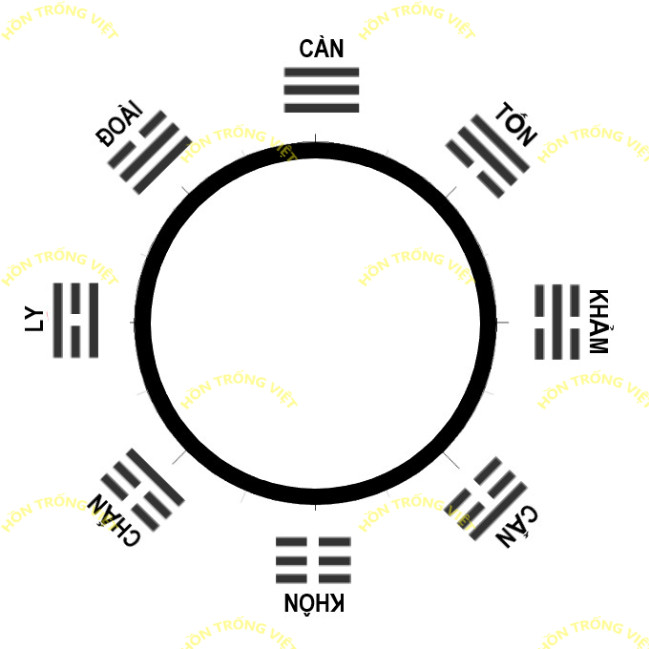

Eight Trigrams or Bat Quai

Solid line is Yang, broken line is Yin2In fact, the words Yin & Yang were not mentioned in the I Ching until the writing of the Ten wings. Nguyễn Hiến Lê: Kinh Dịch Đạo Của Người Quân Tử, NXB Hồng Đức. The figure formed by 3 overlapping lines of Yin or yang are called trigram. There are 8 trigrams called Bat quai. Each trigram that overlaps itself or another trigram is called a double trigram or hexagram, consisting of 6 lines. Each trigram has many different meanings, typically:
| Figure, Statue | Name (Vietnamese) | In nature | Nature | |
| 1 | ☰ | Can, Thien (Càn, Thiên) | Heaven, sun | Hard, Strong, big |
| 2 | ☱ | Doai, Trach (Đoài, Trạch) | Lake | Happy |
| 3 | ☲ | Ly, Hoa (Ly, Hỏa) | Fire | Bright, hot |
| 4 | ☳ | Chan, Loi (Chấn, Lôi) | Lightning, thunder | Movement |
| 5 | ☴ | Ton, Phong (Tốn, Phong) | Wind. Air | Smooth |
| 6 | ☵ | Kham, Thuy (Khảm, Thủy) | Water | Dark, perilous |
| 7 | ☶ | Can, Son (Cấn, Sơn) | Mountain | Quiet, steady |
| 8 | ☷ | Khon, Dia (Khôn, Địa) | Worldly life, Earth | Soft, weak, small |
Lac Thu
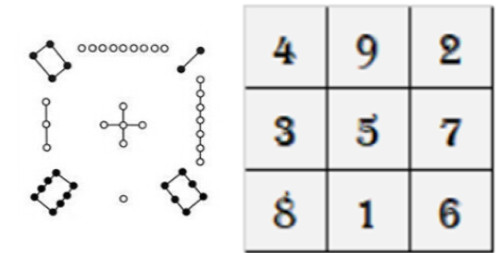
2298 – 2198 BC: Dai Vu, the founder of the Xia Dynasty, found the Lac Thu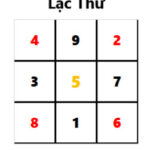 Đồ hình của Kinh Dịch, phối với Hậu Thiên Bát Quái (HTBQ). Lac Thu, a I Ching's Diagram that associates with the Late Heaven Eight... More on the back of the Divine Tortoise.
Đồ hình của Kinh Dịch, phối với Hậu Thiên Bát Quái (HTBQ). Lac Thu, a I Ching's Diagram that associates with the Late Heaven Eight... More on the back of the Divine Tortoise.
Late Heaven Eight Trigrams, 64 Hexagrams & the Sutra
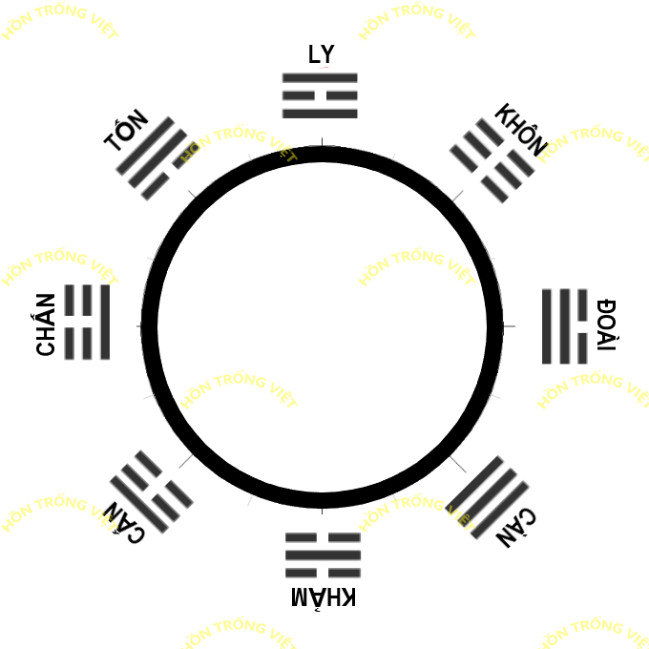
1110 – 1043 BC: King Wen, the founder of the Zhou Dynasty, created the Late heaven eight trigrams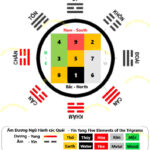 HTBQ là một đồ hình Bát quái của Kinh Dịch. HTBQ phối với Lạc Thư. HTBQ or Late Heaven Eight Trigrams is I Ching's 8... More from Lac Thu
HTBQ là một đồ hình Bát quái của Kinh Dịch. HTBQ phối với Lạc Thư. HTBQ or Late Heaven Eight Trigrams is I Ching's 8... More from Lac Thu Đồ hình của Kinh Dịch, phối với Hậu Thiên Bát Quái (HTBQ). Lac Thu, a I Ching's Diagram that associates with the Late Heaven Eight... More, rearranged 64 hexagrams called the late heaven 64 hexagrams & gave a short statement about each hexagram as a whole.
Đồ hình của Kinh Dịch, phối với Hậu Thiên Bát Quái (HTBQ). Lac Thu, a I Ching's Diagram that associates with the Late Heaven Eight... More, rearranged 64 hexagrams called the late heaven 64 hexagrams & gave a short statement about each hexagram as a whole.
1040 – Mr. Chu Cong Dan, the son of King Wen, wrote comments on each line of the 64 hexagrams, for a total of 64 * 6 = 384 lines.
Together, the hexagrams’ & the line’s comments are called Sutra.

Ten Wings
551 – 479 BC: Confucius3There are authors, including Chinese who don’t agree. It is more likely that Ten Wings is a product of the group of scholars including Confucius, Taoists & others, written over a period from around 500 to 221 BC. Nguyễn Hiến Lê: Kinh Dịch Đạo Của Người Quân Tử, NXB Hồng Đức, a philosopher and politician of the Spring and Autumn period, wrote a detailed explanations on the I Ching called Ten Wings4implying that the commentaries are like the wings to allow I Ching’s sutra as a bird to fly. Nguyễn Hiến Lê: Kinh Dịch Đạo Của Người Quân Tử, NXB Hồng Đức. The Ten Wings since then becomes an inseparable component of the I Ching.
This event is so significant & is considered a systematization of the I Ching.
Also, in the Ten Wings, the process from the Thai Cuc (Tai Chi) to Eight trigrams is described as below.

The Relationships between the Diagrams
156 – 87 BC: during the reign of Emperor Wu, the I Ching was mentioned with only 8 trigrams & Late Heaven’s 64 hexagrams, the Sutra & Ten Wings5Nguyễn Vũ Tuấn Anh: Tìm về cội nguồn Kinh Dịch, NXB Đại học quốc gia TP. Hồ chí Minh 2001.
1011-1077: Mr. Thieu Khang Tiet, Song Dynasty, published the book named “Mai Hoa Dich So” where, for the first time, the diagrams: Tai chi, Ha do Hồng Thư, đồ hình nền tảng của Dịch Trống Việt. Hồng Thư phối với Bát Quái Hồng Thư (BQHT). Hồng thư giống Hà đồ của... More, Lac Thu
Hồng Thư, đồ hình nền tảng của Dịch Trống Việt. Hồng Thư phối với Bát Quái Hồng Thư (BQHT). Hồng thư giống Hà đồ của... More, Lac Thu Đồ hình của Kinh Dịch, phối với Hậu Thiên Bát Quái (HTBQ). Lac Thu, a I Ching's Diagram that associates with the Late Heaven Eight... More were published & displayed, the distinction of early & late heaven 8 trigrams
Đồ hình của Kinh Dịch, phối với Hậu Thiên Bát Quái (HTBQ). Lac Thu, a I Ching's Diagram that associates with the Late Heaven Eight... More were published & displayed, the distinction of early & late heaven 8 trigrams HTBQ là một đồ hình Bát quái của Kinh Dịch. HTBQ phối với Lạc Thư. HTBQ or Late Heaven Eight Trigrams is I Ching's 8... More, and their relationship with Ha do
HTBQ là một đồ hình Bát quái của Kinh Dịch. HTBQ phối với Lạc Thư. HTBQ or Late Heaven Eight Trigrams is I Ching's 8... More, and their relationship with Ha do Hồng Thư, đồ hình nền tảng của Dịch Trống Việt. Hồng Thư phối với Bát Quái Hồng Thư (BQHT). Hồng thư giống Hà đồ của... More & Lac thu
Hồng Thư, đồ hình nền tảng của Dịch Trống Việt. Hồng Thư phối với Bát Quái Hồng Thư (BQHT). Hồng thư giống Hà đồ của... More & Lac thu Đồ hình của Kinh Dịch, phối với Hậu Thiên Bát Quái (HTBQ). Lac Thu, a I Ching's Diagram that associates with the Late Heaven Eight... More were mentioned & the elements of the eight trigrams were identified according to the 5 Element theory6Nguyễn Vũ Tuấn Anh: Tìm về cội nguồn Kinh Dịch, NXB Đại học quốc gia TP. Hồ chí Minh 2001.
Đồ hình của Kinh Dịch, phối với Hậu Thiên Bát Quái (HTBQ). Lac Thu, a I Ching's Diagram that associates with the Late Heaven Eight... More were mentioned & the elements of the eight trigrams were identified according to the 5 Element theory6Nguyễn Vũ Tuấn Anh: Tìm về cội nguồn Kinh Dịch, NXB Đại học quốc gia TP. Hồ chí Minh 2001.
